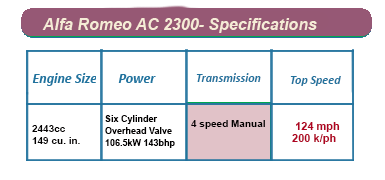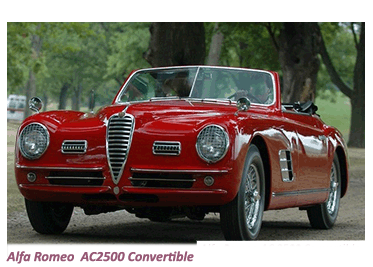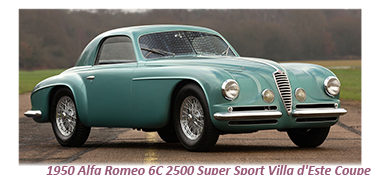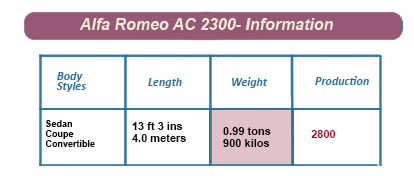
Alfa Romeo succeeded in pulling themselves out of the rubble of World War Two thanks to their rapid re-introduction of their 6C2500
The Alfa Romeo 6C2500 first made its debut in the late Thirties and in the short time before Italy found themselves embroiled in the war, proved to be a steady seller.
 A throwback to the post-war years in Italy, the AC2300 was the last of the Alfa Romeo series of six-cylinder cars to be released. that began with the 6C 1500, launched in 1928.
A throwback to the post-war years in Italy, the AC2300 was the last of the Alfa Romeo series of six-cylinder cars to be released. that began with the 6C 1500, launched in 1928.
When it reappeared in 1946, the AC2300 was dated in appearance, yet still had a lot of class and an equally formidable price ticket.
Those few Italians who could afford to buy and run a car had very few options. Even though the immediate-post war years were austere times, there were very few compact vehicles available on the domestic market in Italy.
![]()
 One of the few options available, the Series Two AC2300 was marketed as the Freccia dOrci or “Golden Arrow' series provided a compelling combination of comfort, style, and speed for those who had the finance to afford it.
One of the few options available, the Series Two AC2300 was marketed as the Freccia dOrci or “Golden Arrow' series provided a compelling combination of comfort, style, and speed for those who had the finance to afford it.
The AC2300 was available as a two-door and four-door sedan as a well as Sports two-door cabriolet model, all of which offered ample space for the driver and four passengers.
 Each version was typified by its narrow grille made up of horizontal strips, a long hood split windshield, and double-bar split bumpers.
Each version was typified by its narrow grille made up of horizontal strips, a long hood split windshield, and double-bar split bumpers.
Large parking lights sat inboard of the built-in headlamps while the hardtop models came fitted with dainty rear windows.
![]()
 For ease of use, the luggage compartment of the AC2300 could be opened from inside the car and held a spare wheel on a glider mechanism for easy extraction.
For ease of use, the luggage compartment of the AC2300 could be opened from inside the car and held a spare wheel on a glider mechanism for easy extraction.
The AC2300’s bumpers were fixed on the chassis, independent from the body with came with two built-in jacks mounted near the doors. Despite its extravagant exterior, sparseness was the order as far as the AC's interior was concerned, with the exception of the car’s upholstery, available in either a rich material or even velvet.
Dashboard control knobs were a choice of either plexiglass or an elaborate form of artificial ivory known as Ivorite.
 Fitted as standard on the AC2300 were twin windshield wipers.
Fitted as standard on the AC2300 were twin windshield wipers.
A rear-view mirror, ashtrays, sun shades, Snap-Fobs, and direction indicators.
Based on the racing engines built by Alfa Romeo before World War II, the AC2300 engines delivered at least 90 bhp thanks to its twin overhead camshafts with either single or triple Weber carburettors, while the Super Sports (SS), which carried a higher-powered version of the dual-overhead-cam engine. 
The AC2300 came fitted with a four-speed gearbox as standard that formed a unit with the engine block and worked through a single-disc, elastic hub, dry plate clutch.
A column gearshift lever was conveniently placed just under the steering wheel.
A lfa Romeo described their AC2300 sedan as " streamlined, slim and elegant car for speedy touring' thanks to its all-metal body made of steel tube and steel section members,combined with the aluminium sheet panels that made up most of the body making the AC2300 extremely light in weight for such a large vehicle.
lfa Romeo described their AC2300 sedan as " streamlined, slim and elegant car for speedy touring' thanks to its all-metal body made of steel tube and steel section members,combined with the aluminium sheet panels that made up most of the body making the AC2300 extremely light in weight for such a large vehicle.
 bulky pre-war design meant that it was soon phased out, replaced by the 1900 Series.
bulky pre-war design meant that it was soon phased out, replaced by the 1900 Series.
A total of 2800 post-war AC2300s were produced post-war, a very respectable figure considering the times and the fact that it was one of the most expensive production cars in Europe at that point.


